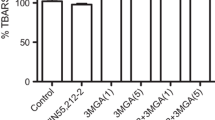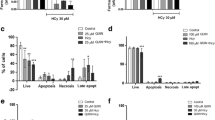Abstract
The effect of homocysteine (HCY) on lipid peroxidation (LP), a current mechanism of oxidative neurotoxicity, was investigated in rat brain synaptosomes. LP was assessed by measuring the amount of thiobarbituric acid-reactive substances (TBARS) formed from synaptosomal fractions following HCY treatment. Increasing HCY concentrations (5–1000 μM) enhanced the TBARS formation in brain synaptosomes in a concentration-dependent manner. When compared at equimolar concentrations (100 μM), the oxidative potency of HCY was lower than that of the oxidant ferrous sulfate, similar to that produced by glutamate (Glu) and the mitochondrial toxin 3-nitropropionic acid, and higher than that of the Glu agonists, kainate and quinolinate. TheN-methyl-D-aspartate receptor (NMDAr) antagonist dizocilpine (MK-801) completely blocked the HCY-induced LP at concentrations from 5 to 1000 μM, whereas the well-known antioxidantN-acetylcysteine (NAC) was less effective, but still protective against the HCY oxidative toxicity at higher concentrations (400 and 1000 μM). Three nitric oxide synthase (NOS) inhibitors, 7-nitroindazole (7-NI),Nω-nitro-L-arginine (L-NARG) andNω-nitro-L-arginine methyl ester (L-NAME), were also tested on HCY-induced LP at increasing concentrations. Both nonspecific NOS effectively the HCY-induced LP than did the selective neuronal NOS inhibitor, 7-NI. These results show that submillimolar concentrations of HCY can induce oxidative injury to nerve terminals, and this effect involves NMDAr stimulation, NOS activation, and associated free radicals formation.
Similar content being viewed by others
References
Bredt DS and SH Snyder (1990) Isolation of nitric oxide synthase, a calmodulin-requiring enzyme.Proc. Natl. Acad. Sci. USA 87, 682–685.
Byler DM, DK Grosser and H Sushi (1983) Spectroscopic estimation of the extent ofS-nitrothiol formation by nitrite action on sulfhydryl groups.J. Agric. Food Chem. 31, 523–527.
Cotman CW and OA Matthews (1971) Synaptic plasma membranes from rat brain synaptosomes: isolation and partial characterization.Biochim. Biophys. Acta 249, 380–394.
Coyle JT and P Puttfarcken (1993) Oxidative stress, glutamate, and neurodegenerative disorders.Science 262, 689–695.
D'Emilia DM and SA Lipton (1999) Ratio ofS-nitrosohomocyst(e)ine to homocyst(e)ine or other thiols determines neurotoxicity in rat cerebrocortical cultures.Neurosci. Lett. 265, 103–106.
Deigner HP, U Haberkorn, and R Kinscherf (2000) Apoptosis modulators in the therapy of neurodegenerative diseases.Expert Opin. Investig. Drugs 9, 747–764.
Folbergrová J, V Lisý, R Haugvicová and F Št'astný (1997) Specific [3H]glutamate binding in the cerebral cortex and hippocampus of rats during development: effect of homocysteine-induced seizures.Neurochem. Res. 22, 637–646.
Fontaine MA, JW Geddes, A Banks and DA Butterfield (2000) Effect of exogenous and endogenous antioxidants on 3-nitropropionic acid-inducedin vivo oxidative stress and striatal lesions: insights into Huntington's disease.J. Neurochem. 75, 1709–1715.
Garthwaite J (1991) Glutamate, nitric oxide and cell-cell signaling in the nervous system.Trends Neurosci.14, 60–67.
Garthwaite J, G Garthwaite, RMJ Palmer and S Moncada (1989) NMDA receptor activation induces nitric oxide synthesis from arginine in rat brain slices.Eur. J. Pharmacol. 172, 413–416.
Halliwell B (1991) Drug antioxidant effects. A basis for drug selection?Drugs 42, 569–605.
Hirano K, T Ogihara, M Miki, H Yasuda, H Tamai, N Kawamura and M Mino (1994) Homocysteine induces iron-catalyzed lipid peroxidation of low-density lipoprotein that is prevented by alphatocopherol.Free Rad. Res. 21, 267–276.
Imam SZ, JP Crow, GD Newport, F Islam, W Slikker Jr and SF Ali (1999) Methamphetamine generates peroxynitrite and produces dopaminergic neurotoxicity in mice: protective effects of peroxynitrite decomposition catalyst.Brain Res. 837, 15–21.
Jacobsen DW (2000) Hyperhomocysteinemia and oxidative stress: time for a reality check?Arterios. Thromb. Vasc. Biol. 20, 1182.
Jones BG, FA Rose and N Tudball (1994) Lipid peroxidation and homocysteine induced toxicity.Atherosclerosis 105, 165–170.
Kannan K and SK Jain (2000) Oxidative stress and apoptosis.Pathophysiology 7, 153–163.
Kashii S, M Mandai, M Kikuchi, Y Honda, Y Tamura, K Kaneda and A Akaike (1996) Dual actions of nitric oxide inN-methyl-D-aspartate receptor-mediated neurotoxicity in cultured retinal neurons.Brain Res. 711, 93–101.
Kiedrowski L, E Costa and JT Wroblewski (1992) Glutamate receptor agonists stimulate nitric oxide synthase in primary cultures of cerebellar granule cells.J. Neurochem. 58, 335–341.
Kim W-K (1999)S-Nitrosation ameliorates homocysteine-induced neurotoxicity and calcium responses in primary culture of rat cortical neurons.Neurosci. Lett. 265, 99–102.
Kim W-K and Y-S Pae (1996) Involvement ofN-methyl-D-aspartate receptor and free radical in homocysteine-mediated toxicity on rat cerebellar granule cells in culture.Neurosci. Lett. 216, 117–120.
Koenig H, JJ Trout, AD Goldstone and CY Lu (1992) Capillary NMDA receptors regulate blood-brain function and breakdown.Brain Res. 588, 297–303.
Lipton SA, YB Choi, ZH Pan, SZ Lei, HSV Chen, NJ Sucher, J Loscalzo, DJ Singel and JS Stamler (1993) A redox-based mechanism for the neurodestructive effects of nitric oxide and related nitroso-compounds.Nature 364, 626–632.
Lipton SA, W-K Kim, Y-B Choi, S Kumar, DM D'Emilia, V Rayudu, DR Arnelle and JS Stamler (1997) Neurotoxicity associated with dual actions of homocysteine at theN-methyl-D-aspartate receptor.Proc. Natl. Acad. Sci. USA 94, 5923–5928.
Martínez M, AI Hernández and N Martínez (2000)N-acetylcysteine delays age-associated memory impairment in mice: role in synaptic mitochondria.Brain Res. 855, 100–106.
McCully, K.S. (1969) Vascular pathology of homocysteinemia: implications for the pathogenesis of arteriosclerosis.Am. J. Pathol. 56, 111–128.
Moncada S, RMJ Palmer and FA Higgs (1989) Biosynthesis of nitric oxide from L-arginine: a pathway for the regulation of cell function and communication.Biochem. Pharmacol. 38, 1709–1715.
Nakazawa H, C Genka and M Fujishima (1996) Pathological aspects of active oxygens/free radicals.Japan J. Physiol. 46, 15–32.
Noak H, J Lindenau, F Rothe, R Asayama and G Wolf (1998) Differential expression of superoxide dismutase isoforms in neuronal and glial compartments in the course of excitotoxically mediated neurodegeneration: Relation to oxidative and nitrergic stress.Glia 23, 285–297.
O'Byrne, MB and KF Tipton (2002) Inhibition of the neuronal isoform of nitric oxide synthase significantly attenuates 1-methyl-4-phenylpyridinium (MPP(+)) toxicityin vitro. J. Neural Transm. 109, 585–596.
Pérez-Severiano F, B Escalante and C Ríos (1998) Nitric oxide synthase inhibition prevents acute quinolinate-induced striatal neurotoxicity.Neurochem. Res. 23, 1297–1302.
Pocernich CB, AL Cardin, CL Racine, CM Lauderback and DA Butterfield (2001) Glutathione elevation and its protective role in acrolein-induced protein damage in synaptosomal membranes: relevance to brain lipid peroxidation in neurodegenerative disease.Neurochem. Int. 39, 141–149.
Ríos C and A Santamaría (1991) Quinolinic acid is a potent lipid peroxidant in rat brain homogenates.Neurochem. Res. 16, 1139–1141.
Rubbo H, R Radi, M Trujillo, R Telleri, B Kalyanaraman, S Barnes, M Kirk and BA Freeman (1994) Nitric oxide regulation of superoxide and peroxynitrite-dependent lipid peroxidation.J. Biol. Chem. 269, 26066–26075.
Santamaría A and C Ríos (1993) MK-801, anN-methyl-D-aspartate receptor antagonist, blocks quinolinic acid-induced lipid peroxidation in rat corpus striatum.Neurosci. Lett. 159, 51–54.
Santamaría A, D Santamaría, M Díaz-Muñoz V Espinoza-González and C Ríos (1997) Effects of Nω-nitro-L-arginine and L-arginine on quinolinic acid-induced lipid peroxidation.Toxicol. Lett. 93, 117–124.
Santamaría D, V Espinoza-González, C Ríos and A Santamaría (1999) Nω-Nitro-L-arginine, a nitric oxide synthase inhibitor, antagonizes quinolinic acid-induced neurotoxicity and oxidative stress in rat striatal slices.Neurochem. Res. 24, 843–848.
Santamaría A, S Galván-Arzate, V Lisý, SF Ali, HM Duhart, L Osorio-Rico, C Ríos and F St'astný (2001) Quinolinic acid induces oxidative stress in rat brain synaptosomes.NeuroReport 12, 871–874.
Snyder SH (1993) Janus faces of nitric oxide.Nature 364, 577.
Stamler JS, JA Osborne, O Jaraki, LE Rabbani, M Mullins, D Singel and J Loscalzo (1993) Adverse vascular effects of homocysteine are modulated by endothelium-derived relaxing factor and related oxides of nitrogen.J. Clin. Invest. 91, 308–318.
Starkebaum G, and JM Harlam (1986) Endothelial cell injury due to copper-catalyzed hydrogen peroxide generation from homocysteine.J. Clin. Invest. 77, 405–410.
St'astný F, E Hinoi, K Ogita and Y Yoneda (1999) Ferrous iron modulates quinolinate-mediated [3H]MK-801 binding to rat brain synaptic membranes in the presence of glycine and spermidine.Neurosci. Lett. 262, 105–108.
Wall RT, JM Harlan, LA Harker and GE Striker (1980) Homocysteine-induced endothelial cell injuryin vitro: a model for the study of vascular injury.Thromb. Res. 18, 113–121.
Author information
Authors and Affiliations
Corresponding author
Rights and permissions
About this article
Cite this article
Jara-Prado, A., Ortega-Vazquez, A., Ruano, L.M. et al. Homocysteine-induced brain lipid peroxidation: Effects of NMDA receptor blockade, antioxidant treatment, and nitric oxide synthase inhibition. neurotox res 5, 237–243 (2003). https://doi.org/10.1007/BF03033381
Received:
Revised:
Accepted:
Issue Date:
DOI: https://doi.org/10.1007/BF03033381




